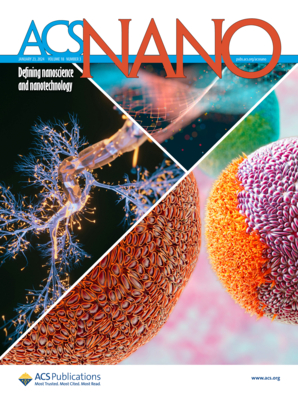掺钾二氧化锰纳米颗粒重编程中性粒细胞钙信号以加速耐甲氧西林金黄色葡萄球菌感染的糖尿病伤口愈合
IF 16
1区 材料科学
Q1 CHEMISTRY, MULTIDISCIPLINARY
引用次数: 0
摘要
中性粒细胞作为第一线免疫细胞,在伴有耐甲氧西林金黄色葡萄球菌(MRSA)感染(D/M设置)的糖尿病伤口中通常会失去优势,在愈合过程中扮演“敌人多于朋友”的角色。具体来说,钙离子(Ca2+)流入减少和钙稳态受损导致中性粒细胞在病原体杀灭和伤口愈合中的顺序行为功能障碍,表现为趋化性抑制、细胞内活性氧(ROS)产生减少、细胞凋亡延长和中性粒细胞胞外陷阱(NETs)保留。为了解决这一挑战,本研究制备了掺杂钾(K)的二氧化锰纳米颗粒(MnO2 NPs),该纳米颗粒通过电子转移诱导中性粒细胞去极化,激活了跨膜Ca2+通道。随后,这促成了最初的Ca2+内流和受损中性粒细胞的重编程Ca2+依赖行为。此外,K-MnO2 NPs的潜在抗菌能力创造了一个良好的细胞外环境,恢复钙稳态,使凋亡的中性粒细胞能够及时清除。因此,在D/M环境下,用K-MnO2 NPs处理的伤口表现出对MRSA的强抗性和快速愈合,这可能归因于K-MnO2 NPs在利用Ca2+内流和维持钙稳态方面的协同作用。总之,在D/M环境下,K-MnO2 NPs是抵抗MRSA和快速伤口愈合的有效策略。本文章由计算机程序翻译,如有差异,请以英文原文为准。

Potassium-Doped MnO2 Nanoparticles Reprogram Neutrophil Calcium Signaling to Accelerate Healing of Methicillin-Resistant Staphylococcus aureus-Infected Diabetic Wounds
Neutrophils, as first-line immune cells, typically lose their edge within the diabetic wounds accompanied by methicillin-resistant Staphylococcus aureus (MRSA) infections (the D/M setting), playing the role of “more foe than friend” during the healing process. Specifically, reduced influx of calcium ions (Ca2+) and impaired calcium homeostasis yield the dysfunction of neutrophil sequential behaviors in pathogen killing and wound healing, manifesting as suppressed chemotaxis, decreased intracellular reactive oxygen species (ROS) generation, prolonged apoptosis, and retention of neutrophil extracellular traps (NETs). To address this challenge, this study fabricated potassium (K)-doped manganese dioxide nanoparticles (MnO2 NPs), which activated transmembrane Ca2+ channels by inducing neutrophil depolarization via electron transfer. Subsequently, this contributed to the initial Ca2+ influx and reprogrammed Ca2+-dependent behaviors of impaired neutrophils. Also, the potential antimicrobial capacity of K-MnO2 NPs created a favorable extracellular environment that restored calcium homeostasis, enabling apoptotic neutrophils to be removed timely. Therefore, the wounds treated with K-MnO2 NPs in the D/M setting exhibited potent resistance to MRSA and rapid healing, which could be attributed to the synergistic effects of K-MnO2 NPs in leveraging Ca2+ influx and maintaining calcium homeostasis. In brief, K-MnO2 NPs constitute an effective strategy to resist MRSA and rapid wound healing in the D/M setting.
求助全文
通过发布文献求助,成功后即可免费获取论文全文。
去求助
来源期刊

ACS Nano
工程技术-材料科学:综合
CiteScore
26.00
自引率
4.10%
发文量
1627
审稿时长
1.7 months
期刊介绍:
ACS Nano, published monthly, serves as an international forum for comprehensive articles on nanoscience and nanotechnology research at the intersections of chemistry, biology, materials science, physics, and engineering. The journal fosters communication among scientists in these communities, facilitating collaboration, new research opportunities, and advancements through discoveries. ACS Nano covers synthesis, assembly, characterization, theory, and simulation of nanostructures, nanobiotechnology, nanofabrication, methods and tools for nanoscience and nanotechnology, and self- and directed-assembly. Alongside original research articles, it offers thorough reviews, perspectives on cutting-edge research, and discussions envisioning the future of nanoscience and nanotechnology.
 求助内容:
求助内容: 应助结果提醒方式:
应助结果提醒方式:


